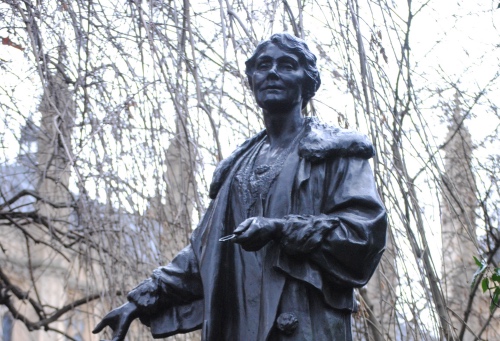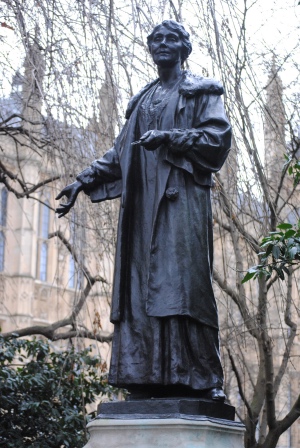
2018 marks the 100th anniversary of the introduction of the UK’s Representation of the People Act in 1918 which gave some women the right to vote for the first time in Great Britain and Ireland, an act which signalled a partial victory at least for the radical campaigners known as the suffragettes. So who were they? DAVID ADAMS finds out…
2018 marks the 100th anniversary of the introduction of the UK’s Representation of the People Act in 1918 which gave some women the right to vote for the first time in Great Britain and Ireland, an act which signalled a partial victory at least for the radical campaigners known as the suffragettes. So who were they? DAVID ADAMS finds out…

A statue in London of Emmeline Pankhurst, one of the most high profile of Britain’s suffragettes. PICTURE: David Adams.
• The suffragettes were among female members of organisations established in the late 19th/early 20th century to push for women to be given the right to vote in public elections. While the word suffragist is used broadly for supporters of the women’s suffrage movement in the UK, the word ‘suffragette‘ (the name is attributed to an article in The Daily Mail newspaper) is generally used to distinguish the more militant branches of the movement, particularly those who were members of the Women’s Social and Political Union (WSPU).
• The Women’s Social and Political Union (WSPU) was established in Manchester on 10th October, 1903, and was a breakaway group from the National Union of Women’s Suffrage Societies (and was one of many groups in the women’s suffrage movement). It was founded by women who were disappointed by the non-militant approach of the NUWSS. It adopted motto of “Deeds not words” and the colours of violet, white and green – symbolising dignity, purity and hope.
• Key figures in the WSPU were sisters Emmeline Pankhurst (pictured) and her daughters Christabel and Sylvia (there was also a lesser known sister named Adela). In 1999, TIME named Emmeline Pankhurst as one of the ‘100 Most Important People of the 20th Century’.
• The suffragettes adopted a range of radical and violent methods – the use of which are still hotly debated today – to draw attention to their cause including hunger strikes, chaining themselves to railings, smashing windows, vandalising golf courses and even bombing or setting fire to churches.
• Emily Wilding Davison become one of the most famous figures in the movement when she died after running out on the track under the hooves of the King’s horse, Anmer, at The Epsom Derby on 4th June, 1913. To this day, the reason which prompted her to run out on the racetrack remains a matter of debate. Her funeral in London was a massive affair.
• More than 1,000 suffragettes across Britain were imprisoned for anti-social behaviour between the dawn of the 20th century and World War I.
• Amid rising concerns over the hunger strikes (and the forced feeding methods being employed on hunger strikers), the British Government passed the Prisoners (Temporary Discharge for Ill Health) Act, 1913. Known as the ‘Cat and Mouse Act‘, it allowed for the temporary release of hunger striking prisoners who could then be placed back in prison once they had recovered their health.
• The outbreak of World War I led to the women involved in the suffrage movement to refocus their attention on the war effort. In mid-1914, the UK Government released all those imprisoned for actions related to the suffrage movement under an amnesty. Militant suffragette activities ceased soon after.
• On 6th February, 1918, the British Parliament passed the Representation of the People Act which enfranchised women aged over 30 who had minimum property ownership qualifications (it also extended the eligibility of men to vote, dropping the voting age from 30 to 21). In November that year, the Parliament (Qualification of Women) Act was passed, allowing women to be elected to parliament. Ten years later, in 1928, the UK Parliament passed the Representation of the People Act which dropped the voting age for women to 21.
• Britain was not the first nation to extend the public vote to women – that honour goes to New Zealand which did so in 1893 (although women couldn’t stand for Parliament and New Zealand was at that time a colony) and was followed by Australia – the first independent nation to do so – in 1903. In the US, women did not get the vote at a national level until 1920.
ADDITIONAL SOURCES:
• UK Parliament – Women and the Vote
• History Extra – 10 things you (probably) didn’t know about the Suffragettes
• BBC – Women’s Suffrage Movement






